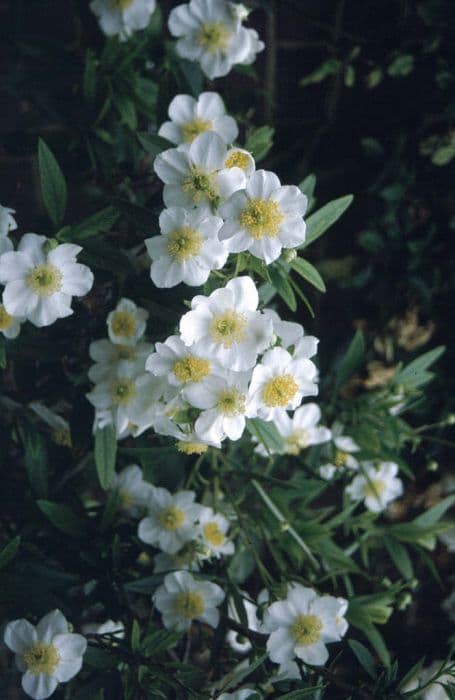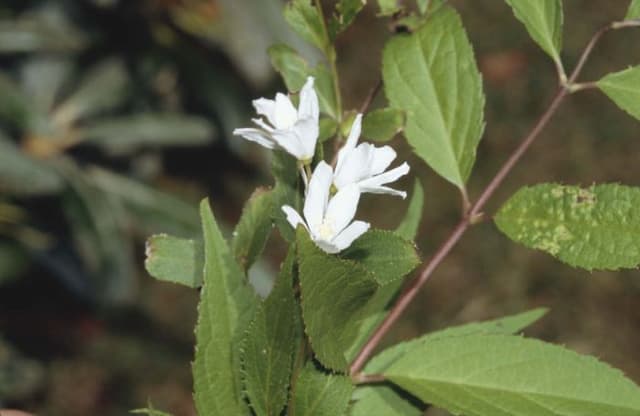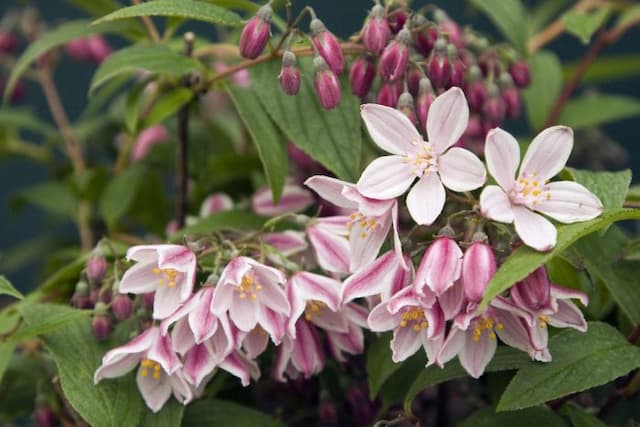Yuki Cherry Blossom Deutzia × rosea

ABOUT
Deutzia × rosea, commonly known as Pink Deutzia, is a deciduous shrub that is cherished for its beautiful appearance. This plant blooms profusely in the spring, showcasing clusters of delicate pink flowers that bloom along its branches. The flowers are notably small and star-shaped, gathered in conical or rounded clusters that provide a soft, yet dense floral display. The foliage of Pink Deutzia is also quite attractive. The leaves are a bright green color, oval to lance-shaped, with edges that can be either smooth or slightly serrated. In the fall, the leaves may turn to a subtle palette of autumnal colors before they drop, adding seasonal interest to the plant's display. The stems of the plant are slender and arch gracefully, which adds to the overall elegance of the Pink Deutzia. When not in bloom, the shrub's form and the texture of its leaves ensure that it remains a pleasing addition to any garden. With its charming flowers and pleasing foliage, Pink Deutzia makes for a delightful ornamental plant in many garden settings.
About this plant
 Names
NamesFamily
Hydrangeaceae
Synonyms
Pink Deutzia, Rose Deutzia
Common names
Deutzia × rosea.
 Toxicity
ToxicityTo humans
Deutzia × rosea, commonly known as slender deutzia, is not listed as a toxic plant to humans. However, it's always sensible to exercise caution and avoid ingesting any part of ornamental plants as a general safety guideline. There is no widely reported toxicity or known symptoms associated with slender deutzia, and it is generally considered safe around humans with respect to toxicity.
To pets
Slender deutzia is not known to be toxic to pets. There is no specific information on toxicity of Deutzia × rosea, or slender deutzia, to animals, and it is not listed by major pet poison resources as a plant with toxic potential. However, as with any non-food plants, monitoring your pets and preventing them from chewing on or ingesting the plant is a good precaution. If a pet appears to be unwell after interacting with any plant, it is advised to consult a veterinarian.
 Characteristics
CharacteristicsLife cycle
Perennials
Foliage type
Deciduous
Color of leaves
Green
Flower color
Pink
Height
2-4 feet (0.6-1.2 meters)
Spread
2-4 feet (0.6-1.2 meters)
Plant type
Shrub
Hardiness zones
5
Native area
Asia
Benefits
 General Benefits
General Benefits- Ornamental Appeal: Deutzia × rosea, commonly known as the Pink Deutzia, is prized for its decorative pink blooms that add color and visual interest to gardens.
- Low Maintenance: The Pink Deutzia is relatively easy to care for, requiring minimal pruning and attention once established.
- Drought Tolerance: Once established, it can tolerate periods of drought, making it suitable for gardens in drier climates.
- Attracts Pollinators: The flowers of the Pink Deutzia attract bees and butterflies, promoting pollination in the garden.
- Seasonal Interest: This plant offers seasonal interest with its spring bloom and in some varieties, autumn foliage color.
- Versatility: Pink Deutzia can be used in various landscape designs, including borders, foundation plantings, and as specimen plants.
- Cold Hardy: It is generally cold hardy, surviving in cooler climates where other plants may not thrive.
 Medical Properties
Medical PropertiesThis plant is not used for medical purposes.
 Air-purifying Qualities
Air-purifying QualitiesThis plant is not specifically known for air purifying qualities.
 Other Uses
Other Uses- Yoraku-fence Accent: In Japan, Deutzia × rosea, also known as Yukiyanagi, branches are sometimes used to create beautiful accents in traditional bamboo fences.
- Bonsai Cultivation: Yukiyanagi is suitable for bonsai cultivation, allowing enthusiasts to create miniature landscapes or garden scenes.
- Photographic Subject: With its picturesque pink blooms, Yukiyanagi is often used as a subject for botanical photography, capturing the intricate details of its flowers.
- Artistic Inspiration: The delicate blossoms of Yukiyanagi inspire artists and can be found represented in watercolor paintings and floral designs.
- Craft Applications: Dried branches of Yukiyanagi can be used in craft projects, such as wreath making or as part of dried floral arrangements.
- Education and Research: Yukiyanagi, as a hybrid plant, provides a valuable study subject for horticulture students and plant hybridization researchers.
- Festival Decorations: In some cultures, the branches and blooms of Yukiyanagi are used as decorations during certain festivals, particularly in spring celebrations.
- Nature-Based Dyes: The petals of Yukiyanagi flowers may be used in the production of natural dyes for fabric coloring or art projects.
- Insect Attraction in Gardens: Planting Yukiyanagi can help attract beneficial insects to gardens, like bees and butterflies, aiding in pollination of surrounding plants.
- Culinary Garnish: Although not commonly consumed, the flowers of Yukiyanagi might be used as an edible garnish for their visual appeal in haute cuisine.
Interesting Facts
 Feng Shui
Feng ShuiThe plant Deutzia is not used in Feng Shui practice.
 Zodiac Sign Compitability
Zodiac Sign CompitabilityThe plant Deutzia is not used in astrology practice.
 Plant Symbolism
Plant Symbolism- Beauty: The Deutzia × rosea, commonly known as Pink Deutzia, produces attractive pink blooms that symbolize beauty and delicacy in the floral world.
- Humility: Despite its striking appearance, Pink Deutzia grows without demanding much attention, embodying a spirit of humility.
- Purity: The clear, soft hues of Pink Deutzia flowers are often associated with purity and innocence.
- Rejuvenation: Blooming in the spring, Pink Deutzia signifies rebirth and the refreshing quality of nature as it reawakens after winter.
 Water
WaterDeutzia, more commonly known as the Pink Deutzia, prefers even moisture, so water regularly to keep the soil from drying out completely. During the active growing season in spring and summer, this usually translates to watering once a week with approximately 1-2 gallons of water, depending on weather conditions like heat and wind which can increase the need for water. In the fall and winter, reduce watering to every two to three weeks or when the soil feels dry to the touch, providing 1-2 gallons, as the plant's water requirements decrease with cooler temperatures and reduced sunlight.
 Light
LightPink Deutzia thrives in areas that receive full sun to partial shade. The best spot would be one where the plant gets at least 4-6 hours of direct sunlight per day, with some relief from the intense afternoon sun if possible, to prevent scorching of the leaves. An eastern or western exposure is ideal for balancing light and protecting the plant from the harsh midday sun.
 Temperature
TemperaturePink Deutzia is hardy and can tolerate a range of temperatures but performs best when the daytime temperature is between 60°F and 75°F. It can survive minimum temperatures down to around -10°F but should be protected from prolonged periods of extreme cold. Ideally, it should not be exposed to temperatures above 85°F for extended periods as this can stress the plant.
 Pruning
PruningPink Deutzia should be pruned right after it finishes flowering in late spring to early summer to maintain its shape and encourage the growth of new blooms for the next season. Remove any dead or damaged wood, and thin out the center of the plant to improve air circulation. Cut back up to one-third of the oldest stems to ground level to rejuvenate the plant if needed. Pruning yearly will help keep it healthy and vibrant.
 Cleaning
CleaningAs needed
 Soil
SoilYuki Cherry Blossom Deutzia thrives in well-draining, fertile soil with a pH range of 6.0 to 7.5. A mix of loam, peat, and sand in equal parts is ideal for ensuring proper drainage and fertility.
 Repotting
RepottingYuki Cherry Blossom Deutzia should be repotted every 2 to 3 years to provide fresh nutrients and encourage healthy growth.
 Humidity & Misting
Humidity & MistingYuki Cherry Blossom Deutzia prefers average humidity levels; however, it can tolerate a range from slightly dry to moderately humid conditions without any special humidity adjustments.
 Suitable locations
Suitable locationsIndoor
Place in bright, indirect light and water moderately.
Outdoor
Plant in partial shade, enrich soil, water regularly.
Hardiness zone
5-8 USDA
 Life cycle
Life cycleDeutzia × rosea, also known as Pink Pride of Rochester, starts its life as a seed which, when conditions are favorable, germinates and grows into a young seedling. With enough light, water, and soil nutrients, the seedling develops into a mature bush featuring a woody stem and a lush foliage of leaves. Annually, typically in late spring or early summer, it enters a flowering stage where clusters of pink flowers bloom, attracting pollinators such as bees and butterflies. After pollination, the flowers may produce small, dry fruit containing seeds, perpetuating the cycle. As a deciduous shrub, it experiences a dormant phase in the winter where it sheds leaves to conserve resources. Over many years, the plant will grow larger, but as it ages, it may require pruning to maintain health and vigor, and it will eventually reach the end of its life span and die.
 Propogation
PropogationPropogation time
Early spring
Propogation: Deutzia × rosea, commonly known as Yuki Cherry Blossom™, is often propagated by softwood cuttings. This method is usually performed in late spring or early summer when new growth is still green and flexible. Cuttings should be about 4 to 6 inches long and include several sets of leaves. The lower set of leaves is removed, and the cut end of the cutting can be dipped in rooting hormone to encourage root development. Then, the cuttings are placed in a well-drained potting mix, making sure at least one node is below the surface where roots will form. The environment should be kept humid, and the soil should be consistently moist but not waterlogged. Root development usually occurs in a few weeks, after which the new plants can be gradually acclimated to less humid conditions before being transplanted to their final location.







![Hydrangea [Strong Annabelle]](/_next/image?url=https%3A%2F%2Fplants-admin.emdemapps.com%2Fimages%2Fplants%2F%2Fimages%2F604b54db37d34.png&w=640&q=75)

